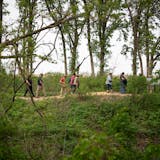It's a dilemma that cities grapple with statewide and nationwide: an aging population and other significant demographic changes, but also tighter budgets and smaller staffs to tackle "to do" lists.
Cue the next generation.
This year, dozens of graduate students at the University of Minnesota are trading classrooms for City Hall, working alongside the city staff in Minnetonka to dig up new solutions to issues -- from conserving water to attracting more mid-priced housing for younger families.
It's part of a program the university is testing in Minnetonka this year before expanding it statewide. The program, which officially starts Friday, is designed to help cities better respond to changes and sustainability problems and also to give students real-world experience.
While the university often collaborates with cities and counties, the yearlong project takes that to a new level, giving about 130 students the rare task of working together across multiple departments from law to civil engineering.
"It's really at a scope and scale we don't typically see at a university," said program manager Mike Greco, who works for the U's Center for Urban and Regional Affairs.
"It was a way to scale up the work the university does. And that benefits both sides [the city and school]."
It's one of a few programs in the country modeled after one started at the University of Oregon in 2009. In October, other Minnesota cities can apply to be in the program for next year.
![Three weeks ago, Octavio Rodriguez switched from making transmission parts to casting parts for hospital bed brake assemblies at Twin City Die Castings. ] GLEN STUBBE • glen.stubbe@startribune.com Thursday, April 9, 2020 How employee-owned Twin City Die Casting, which just laid off 40 production workers of its 250 employees in what was supposed to be a good year, is trying to accelerate its pivot to growing medical parts business for ventilators, hospital beds, etc as it copes with instan](https://arc.stimg.co/startribunemedia/WNZYKGTZ5IYMUCO3KI5TR3N7WI.jpg?&w=80&ar=1:1&fit=crop)
djoles@startribune.com As boaters flock to Minnesota lakes and rivers this holiday weekend for the unofficial kick-off to the boating season, they'll face more inspections in and out of the water as local cities and counties ramp up their work to stop the spread of invasive species. Across the metro, more boat accesses will be staffed by watercraft inspectors thanks to $10 million funneled to county government programs this year, up from $4.5 million the state allocated last year. ORG XMIT: MIN1505222156290209 ORG XMIT: MIN1506021218440580](https://arc.stimg.co/startribunemedia/34QSKO44B2XKVNUZCO5SLJQSLY.jpg?&w=80&ar=1:1&fit=crop)

